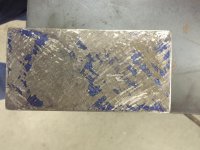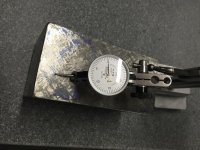Here's a practice piece I scraped not too long ago. It's the bottom surface of a v-block, just because it was handy. Included is one picture near the beginning, one in the middle, and then the final surface. There were about 30 cycles from start to finish. This was the first piece I've tried to scrape and one of the mistakes I made was I started spotting way too early. Does anyone have any other criticisms or advice they could lend? Even in the final picture, I know there are still some areas to the right of the picture that could be improved on, but like I said it was just a piece to get some practice on. In the third picture, you can see some scratches, I think that was due to my deburring stone loading up. How about the thickness of the spotting ink? It seems like I was using too thick at times, even though it seemed I could see the plate through the ink. Oh and I measured the difference between high and low spots and it seemed to average 0.0002 to 0.0004 inches. Equipment used were an Anderson bros carbide tipped scraper, 36x48 grade A plate, dykem ink, medium grit india stone, and a speedball brayer. I was sharpening my scraper to 5* negative using a diamond wheel on a baldor carbide grinder, followed by a light lap with a 1200 grit diamond file. I had the radius way too tight for the majority of the process. And I have also since changed out the handle on my scraper from the typical rounded file handle to a flattened piece of wood so I can push the scraper along with my chest/belly the way Richard King shows in his video. I can really shovel the chips off like that when roughing. But I'm still a novice and still finding my technique that works best for me. All comments are appreciated.












 Just kidding, thanks for sharing and good luck with your scraping project.
Just kidding, thanks for sharing and good luck with your scraping project.